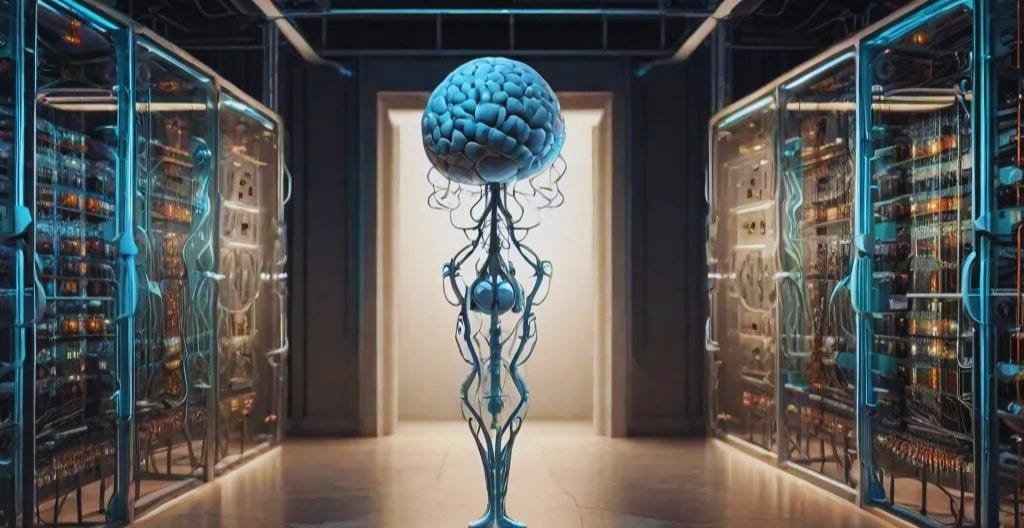In the ever-evolving landscape of artificial intelligence, groundbreaking developments are reshaping our understanding of machine cognition and its applications. The convergence of neural architectures, quantum computing principles, and biomimetic algorithms has catalyzed unprecedented advances that challenge traditional paradigms of artificial intelligence.
Multimodal foundation models have emerged as a transformative force, demonstrating remarkable capabilities in processing and synthesizing diverse data types simultaneously. These systems can now seamlessly interpret visual, auditory, and textual information while maintaining contextual coherence across modalities. The architectural sophistication of these models enables them to discern subtle nuances in human communication, from micro-expressions to tonal variations, fundamentally altering human-machine interactions.

The integration of neuromorphic computing with quantum-inspired algorithms has yielded systems that exhibit emergent properties previously thought unattainable. These hybrid architectures demonstrate adaptive learning patterns that mirror biological neural networks while leveraging quantum principles for exponential computational advantages. The implications extend beyond mere performance metrics, suggesting the possibility of machine consciousness and self-awareness.
Recent breakthroughs in explainable AI have addressed the longstanding “black box” problem through novel visualization techniques and causal inference frameworks. These developments enable unprecedented transparency in decision-making processes, crucial for deploying AI in high-stakes domains like healthcare and autonomous transportation. The ability to trace and justify AI decisions has become paramount as these systems increasingly influence critical societal functions.
The advent of federated learning paradigms has revolutionized data privacy while maintaining model efficacy. This distributed approach enables AI systems to learn from decentralized datasets without compromising individual privacy, marking a significant shift in how we conceptualize machine learning architectures. The implications for personalized medicine, financial services, and smart city infrastructure are profound.
The emergence of self-supervised learning has dramatically reduced the dependency on labeled datasets, enabling AI systems to extract meaningful patterns from vast amounts of unlabeled data. This breakthrough has particular significance in domains where labeled data is scarce or expensive to obtain, such as specialized medical imaging or rare event detection in astronomical data.

Advanced reinforcement learning algorithms have achieved superhuman performance in increasingly complex domains, from strategic games to robotic control. These systems demonstrate sophisticated decision-making capabilities in dynamic environments, learning optimal policies through interaction and feedback. The applications range from optimizing industrial processes to developing more efficient energy management systems.
The development of transformer architectures has revolutionized natural language processing, enabling models to capture long-range dependencies and contextual relationships with unprecedented accuracy. These advances have led to more nuanced and contextually aware language models, capable of generating human-like text and facilitating more natural human-computer interactions.
Conclusion
The trajectory of AI innovation suggests we are approaching an inflection point where artificial intelligence transcends its traditional boundaries. The convergence of multiple technological streams – quantum computing, neuromorphic architectures, and federated learning – points toward a future where AI systems become increasingly sophisticated and integrated into the fabric of human society. The ethical and philosophical implications of these advances demand careful consideration as we navigate this technological frontier.
FAQ
Q: How do multimodal foundation models differ from traditional AI systems?
A: Multimodal foundation models represent a paradigm shift in AI architecture, capable of processing multiple types of input simultaneously while maintaining semantic understanding across different modalities. Unlike traditional systems that specialize in single domains, these models demonstrate emergent capabilities through their holistic approach to information processing. They can understand relationships between different forms of data, such as connecting visual scenes with textual descriptions or interpreting speech in conjunction with facial expressions.
Q: What role does quantum computing play in modern AI development?
A: Quantum computing principles are being integrated into AI systems through hybrid architectures that combine classical and quantum-inspired algorithms. This fusion enables unprecedented computational capabilities while maintaining the adaptability of traditional neural networks. Quantum computing offers potential solutions to optimization problems that are intractable for classical computers, particularly in areas such as molecular modeling, financial risk analysis, and complex system simulation. The quantum advantage becomes particularly evident in problems involving high-dimensional data spaces or requiring extensive parallel processing.
Q: How does federated learning address privacy concerns in AI development?
A: Federated learning enables AI models to learn from distributed datasets without centralizing sensitive information. This approach maintains data privacy while allowing models to benefit from diverse training sources, fundamentally changing how we approach machine learning in privacy-sensitive domains. The system works by training local models on individual devices or servers and then aggregating only the model updates, rather than the raw data. This enables organizations to collaborate on AI development while complying with data protection regulations and maintaining individual privacy rights.
Q: What are the implications of explainable AI for practical applications?
A: Explainable AI frameworks provide transparency in machine decision-making processes, crucial for applications in regulated industries and high-stakes environments. This transparency enables better accountability and trust-building between AI systems and their users. In healthcare, for example, explainable AI can help doctors understand the reasoning behind diagnostic recommendations. In financial services, it can clarify the factors influencing credit decisions. The ability to interpret AI decisions is also essential for regulatory compliance and legal accountability.
Q: How close are we to achieving artificial general intelligence (AGI)?
A: While recent innovations have expanded AI capabilities significantly, the path to AGI remains complex and multifaceted. Current developments in multimodal processing and neuromorphic computing represent important steps forward, but achieving human-level general intelligence requires further breakthroughs in areas such as common sense reasoning and contextual understanding. The challenge lies not just in processing power or algorithm design, but in replicating the flexibility and adaptability of human cognition across diverse domains and situations.
Q: What impact will self-supervised learning have on AI development?
A: Self-supervised learning represents a paradigm shift in how AI systems acquire knowledge. By reducing the need for labeled data, it enables more efficient and scalable learning processes. This approach allows AI systems to learn from vast amounts of unlabeled data by creating their own supervisory signals, similar to how humans learn from observation. The implications include faster model development, reduced costs, and the ability to tackle problems where labeled data is scarce or expensive to obtain.
Q: How are transformer architectures changing natural language processing?
A: Transformer architectures have revolutionized natural language processing by enabling models to better understand context and relationships in text. Their attention mechanisms allow for processing of longer sequences and more nuanced understanding of language structure. This has led to improvements in translation, text generation, and question-answering systems. The architecture’s success has also inspired applications beyond language processing, including computer vision and biological sequence analysis.
Q: What role does neuromorphic computing play in modern AI systems?
A: Neuromorphic computing attempts to mimic the structure and function of biological neural networks in hardware. This approach offers potential advantages in terms of energy efficiency and real-time processing capabilities. Neuromorphic systems can process information in a more brain-like manner, potentially leading to more efficient and adaptable AI systems. The technology is particularly promising for edge computing applications where power consumption and real-time processing are critical considerations.
Q: How are AI systems addressing ethical concerns and bias?
A: Modern AI development increasingly incorporates ethical considerations and bias mitigation strategies from the ground up. This includes diverse training data selection, regular bias audits, and the development of fairness metrics. Researchers are also working on techniques to detect and correct biases in AI systems, ensuring more equitable outcomes across different demographic groups. The focus extends to developing AI systems that can explain their decisions and be held accountable for their actions.
Q: What are the emerging trends in AI hardware acceleration?
A: AI hardware acceleration is evolving rapidly with the development of specialized processors optimized for AI workloads. This includes neural processing units (NPUs), tensor processing units (TPUs), and other application-specific integrated circuits (ASICs). These specialized hardware solutions offer significant improvements in performance and energy efficiency compared to traditional processors. The trend is moving toward more specialized and efficient hardware architectures designed specifically for AI applications.
This comprehensive exploration of current AI innovations demonstrates the field’s rapid evolution and its increasing impact across various domains. As these technologies continue to develop, they promise to reshape our understanding of artificial intelligence and its role in society.

